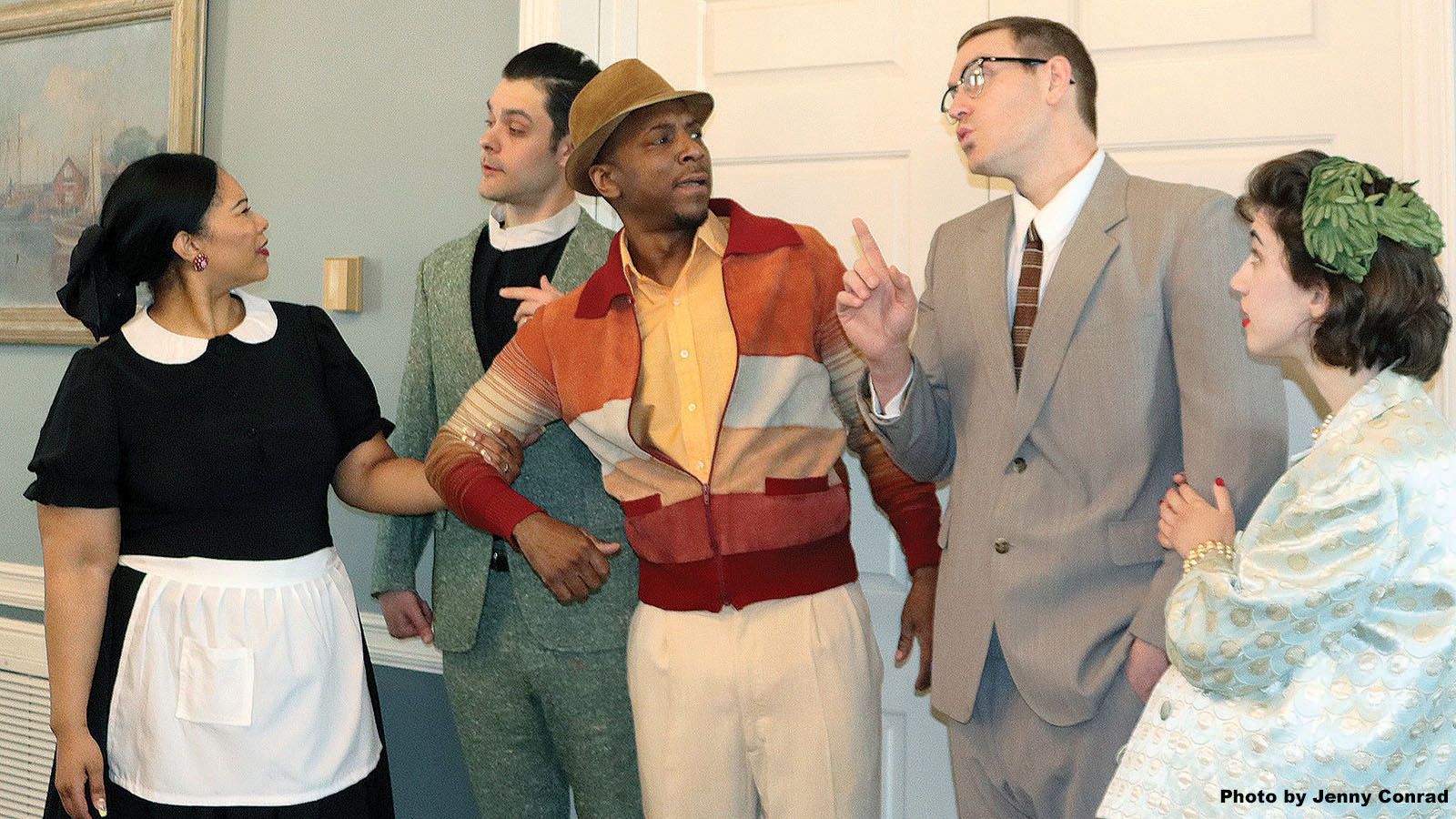When asked why he chose to helm Clybourne Park, currently running at First Presbyterian Theater in downtown Fort Wayne, director Prentis Moore said, “It’s the piece that Fort Wayne needs.”
I would go one step further and say this is the show Fort Wayne needs to see.
The First Pres Theater show holds nothing back, really encouraging conversations with their audience, so much so that First Pres Theaterplanned a panel discussion including civic leaders to further the discourses presented in the play.
The production feels incredibly intimate. The almost cozy feeling of the First Pres Theater performance space lends itself beautifully to the setting of the show where viewers find themselves in the living room of a home in a neighborhood on Chicago’s South Side. The floor of the set is drawn right up to the edge of the audience, which draws viewers into the story, making them feel a part of the often contentious conversations. Speaking of contention, it should be said that the dialogue of Clybourne Park does contain strong language.
Setting the stage
When lights go up on Act 1, set in 1959, we find a rather despondent Russ (portrayed in Week 1 by Kenny Redd and Thomas Wilson in Week 2) losing himself in Neapolitan ice cream and a National Geographic. Meanwhile his picture-perfect wife, Bev (Jen Poiry Prough), is fussing over the packing of their belongings for their move to the north side of Chicago. Their Black housekeeper, Francine (Amber Walker) is assisting when the phone rings with an important call. Francine’s husband, Albert (Cortney White), arrives to take Francine home. Then, minister Jim (Joe Adams) turns up for a visit to check on Russ, who has been withdrawn from the community.
On the phone is Karl (Derek Grabner), who later turns up with his deaf and pregnant wife, Betsy (Elizabeth Harber), to bring the news to Russ and Bev that the family purchasing their home is “colored.” Angered not only by the unwanted attention to his feelings, but also the meddlings of his wife, minister, and neighbor, Russ storms to the cellar, then out of the house entirely. Meanwhile, Jim and Karl ask a cornered Francine and Albert how they would feel about moving into an all-white neighborhood. When Russ returns the conversation escalates, and Jim, Karl, and Betsy leave in a hurry, leaving Bev in tears and Russ fuming.
The entire cast does an excellent job embodying their 1950s roles. The play demands that some of the roles become almost caricatures of everyday lives in that era, and it is obvious that extra care has been taken to portray the period deportment accurately. Prough’s Bev is perfectly on point. She portrays the gracious hostess with ease and captures the naivete of the stereotypical 1950s housewife very well. Her needling is sweet but sharp, and her emotional pleas tug at the audience’s heart strings.
In Act 1 there is a particularly brilliant moment of staging, where, as Karl, Jim, and Russ engage in a rather racist questioning of Francine and Albert, the Black couple are backed against the wall and become trapped upstage while the argument escalates in front of them. This positioning really allows the audience to take advantage of White and Walker’s excellent reactions to the growing tension. This moment also discreetly portrays the trapped feelings of many people of color during the racially divided 1950s.
Don’t move a muscle
When Act 1 ends, the scene makes an epic transformation.
I encourage the audience to remain in the auditorium during the intermission to witness it; by doing so, not only will they get to see the home set into disrepair, but they also will get the opportunity to musically travel through the decades while the destruction happens, as the ambient music progresses from doo wop to hip-hop.
It should also be noted that there is deliberately no blackout at the end of intermission; the transformed cast simply walk on stage and start going about their business.
Switching roles
Act 2, set in 2009, is an incredibly different mood.
The cast have now taken on their more modern roles. Steve (Grabner) and Lindsay (Harber) have purchased the house and plan to tear it down to build a newer, more modern home. They have come with their lawyer Kathy (Prough) to discuss community standards and the historical ramifications of their remodel, with Lena (Walker) and her husband Kevin (White) and their lawyer Tom (Adams). The conversation is continually interrupted, several times by Dan (Redd/Wilson), a construction worker who is digging in the backyard. When conversation is finally able to get moving, Lena points out that the home has historical value, which should be taken into account.
I believe it is Lindsay who points out that change can be good. Lena responds, “It might be responsible to ask ourselves who is responsible for this change and is that really the best thing for the community?”
Steve perceives an undertone of racism. Lindsay tries to prevent him from escalating the conversation by saying something offensive to which Steve quips, “What does offensive even mean?”
This opens a hostile conversation that ultimately leads to more arguments and the rather abrupt end to all civil conversation about the building permit.
Grabner is a standout — his transformation from the ultra-conservative chairman of the board to the uniformed tactless yuppie Steve is seamless. There is definitely a polarizing difference between the two and Grabner navigates it extraordinarily well.
Praise should also be given to Harber for the transformation from Betsy to Lindsay. Where in Act 1 her deaf character utilized predominantly subtle deportment and physicality work to create the character due to lack of speech, Lindsay is outspoken and has her thumb very much on the pulse of political correctness. Harbor’s reactions and emotions are on full display in Act 2.
In the curtain speech, Sandman-Cruz said, “If you don’t leave at least a little offended, we haven’t done our job.”
I encourage all of Fort Wayne to see Clybourne Park and be offended.





